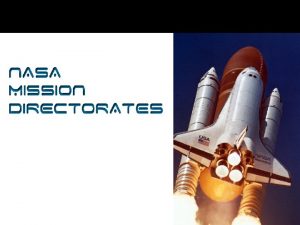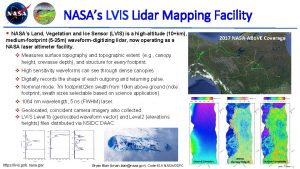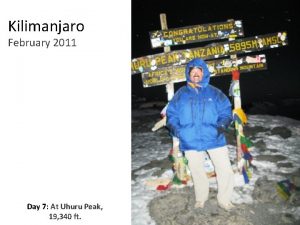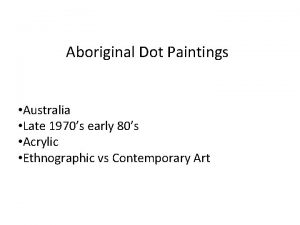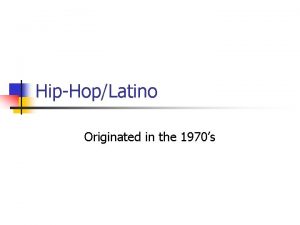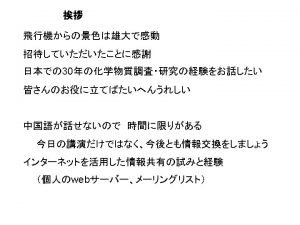Uhuru In the early 1970s NASAs Uhuru X






























































- Slides: 62



























История • Uhuru. In the early 1970's, NASA's Uhuru X -ray satellite, equipped with a relatively simple instrument - a sensitive X-ray detector similar to a Geiger counter attached to a viewing pipe to locate the source -- made some astounding discoveries.

Запуск – 12. 1970 г. До лета 1973 г. Масса 175. 5 кг. Рентген. Счётчики 70 кг Орбита: 520 -560 км, наклон 3 о Тrot=12 min Two sets of proportional counters 2 -20 ke. V 0. 084 m 2 First comprehensive and uniform all sky survey with a sensitivity of 10 -3 the Crab intensity. The 339 X-ray sources detected are binaries, supernova remnants, Seyfert galaxies and cluster of galaxies Discovery of the diffuse X-ray emission from clusters of galaxies



Skylab • The first large focussing Xray telescope was the Apollo Telescope Mount aboard Skylab in the early 1970's. This pioneering telescope used two pairs of concentric mirrors to make stunning X-ray images of the Sun.

Einstein--the First Imaging X-Ray Observatory Launched in 1978, was the first large X-ray telescope with mirrors. It made the first X-ray images of shock waves from exploded stars, and images of hot gas in galaxies and clusters of galaxies. Located over 7000 X-ray sources

ROSAT Germany, the United Kingdom and the United States, carried an even larger X-ray telescope into orbit in 1990. It has expanded the number of known X-ray sources to more than 60, 000 and has proved to be especially valuable for investigating the multi-million degree gas present in the upper atmospheres of many stars.

The Ulysses

• The Ulysses mission is a joint mission with NASA and ESA to explore the solar environment at high ecliptic latitudes. It was launched 6 October 1990, and reached Jupiter for its "gravitational slingshot" in February 1992. It passed the south solar pole in June 1994 and crossed the ecliptic equator in February 1995. In addition to its solar environment instruments, Ulysses also carries plasma instruments to study the interstellar and Jovian regions, as well as two instruments for studying X-rays and gamma-rays of both solar and cosmic origins.



ASCA (Advanced Satellite for Cosmology) • The ASCA X-ray observatory, (Japan and US) launched in 1993, was especially designed to study the detailed distribution of X-rays with energy, which provide important information about the elements that make up the hot X-ray emitting gas.

The Rossi X-ray Timing Explorer (RXTE) is a NASA mission which was launched in December 1995. Although RXTE does not have focusing X-ray mirrors, it has the unique capability to study rapid time variability in the emission of cosmic X-ray sources over a wide band of X-ray energies, and is expected to make valuable contributions to our understanding of neutron stars and black holes.

Beppo. SAX was a program of the Italian Space Agency with participation of the Netherlands Agency for Aerospace Programs. It was launched on April 30, 1996 from Cape Cana eral, and was the first X-ray mission with a scientifi payload covering more than three decades of ene – from 0. 1 to 300 ke. V, with moderate imaging cap bility. Beppo. SAX proved to be useful for X-ray imag sources associated with Gamma-ray bursts

XMM Launched, 10. 12. 99 (X-ray Multi-Mirror satellite. XMM's three huge telescope barrels each hold 58 concentric cylindrical mirrors


The Classification of X-ray Solar Flares




The Yohkoh Satellite • On August 30, 1991 a satellite was launched into space from the Kagoshima Space Center (KSC) in Southern Japan. This satellite, known as Yohkoh ("Sunbeam"), is a project of the Japanese Institute of Space and Astronautical Science (ISAS). The scientific objective has been to observe the energetic phenomena taking place on the Sun, specifically solar flares in x-ray and gammaray emissions.

the Bragg Crystal Spectrometer (BCS) the Wide Band Spectrometer (WBS) the Soft X-Ray Telescope (SXT) the Hard X-Ray Telescope (HXT).

The Soft X-ray Telescope, YOHKOH



A Flaring Loop at the Solar Limb as Seen by Yohkoh










 1970ś
1970ś Novelty stage
Novelty stage X uhuru
X uhuru Najvyšší vrch zeme
Najvyšší vrch zeme Early cpr and early defibrillation can: *
Early cpr and early defibrillation can: * Từ ngữ thể hiện lòng nhân hậu
Từ ngữ thể hiện lòng nhân hậu Sự nuôi và dạy con của hươu
Sự nuôi và dạy con của hươu Diễn thế sinh thái là
Diễn thế sinh thái là Vẽ hình chiếu vuông góc của vật thể sau
Vẽ hình chiếu vuông góc của vật thể sau Làm thế nào để 102-1=99
Làm thế nào để 102-1=99 Tỉ lệ cơ thể trẻ em
Tỉ lệ cơ thể trẻ em Lời thề hippocrates
Lời thề hippocrates đại từ thay thế
đại từ thay thế Vẽ hình chiếu đứng bằng cạnh của vật thể
Vẽ hình chiếu đứng bằng cạnh của vật thể Quá trình desamine hóa có thể tạo ra
Quá trình desamine hóa có thể tạo ra Kể tên các môn thể thao
Kể tên các môn thể thao Công thức tính độ biến thiên đông lượng
Công thức tính độ biến thiên đông lượng Thế nào là mạng điện lắp đặt kiểu nổi
Thế nào là mạng điện lắp đặt kiểu nổi Hình ảnh bộ gõ cơ thể búng tay
Hình ảnh bộ gõ cơ thể búng tay Khi nào hổ con có thể sống độc lập
Khi nào hổ con có thể sống độc lập Dot
Dot Thế nào là sự mỏi cơ
Thế nào là sự mỏi cơ độ dài liên kết
độ dài liên kết Gấu đi như thế nào
Gấu đi như thế nào Thiếu nhi thế giới liên hoan
Thiếu nhi thế giới liên hoan điện thế nghỉ
điện thế nghỉ Một số thể thơ truyền thống
Một số thể thơ truyền thống Trời xanh đây là của chúng ta thể thơ
Trời xanh đây là của chúng ta thể thơ Thế nào là hệ số cao nhất
Thế nào là hệ số cao nhất Ng-html
Ng-html Sơ đồ cơ thể người
Sơ đồ cơ thể người Bảng số nguyên tố lớn hơn 1000
Bảng số nguyên tố lớn hơn 1000 Vẽ hình chiếu vuông góc của vật thể sau
Vẽ hình chiếu vuông góc của vật thể sau đặc điểm cơ thể của người tối cổ
đặc điểm cơ thể của người tối cổ Các châu lục và đại dương trên thế giới
Các châu lục và đại dương trên thế giới Chụp phim tư thế worms-breton
Chụp phim tư thế worms-breton ưu thế lai là gì
ưu thế lai là gì Tư thế ngồi viết
Tư thế ngồi viết Cái miệng bé xinh thế chỉ nói điều hay thôi
Cái miệng bé xinh thế chỉ nói điều hay thôi Cách giải mật thư tọa độ
Cách giải mật thư tọa độ Các châu lục và đại dương trên thế giới
Các châu lục và đại dương trên thế giới Bổ thể
Bổ thể Tư thế ngồi viết
Tư thế ngồi viết Thẻ vin
Thẻ vin Thứ tự các dấu thăng giáng ở hóa biểu
Thứ tự các dấu thăng giáng ở hóa biểu Thơ thất ngôn tứ tuyệt đường luật
Thơ thất ngôn tứ tuyệt đường luật Chúa sống lại
Chúa sống lại Developmental sequence linguistics
Developmental sequence linguistics Smyths reflective framework
Smyths reflective framework National breast and cervical cancer early detection program
National breast and cervical cancer early detection program Stages of early arithmetical learning
Stages of early arithmetical learning Roald dahl early life
Roald dahl early life Tsunami early warning system sri lanka
Tsunami early warning system sri lanka Early childhood education in pakistan
Early childhood education in pakistan Piaget’s stages of artistic development
Piaget’s stages of artistic development Easter is a joyful festival which happens
Easter is a joyful festival which happens Early vs late syphilis
Early vs late syphilis Enlisted evaluation report
Enlisted evaluation report Social impact statement for early design review
Social impact statement for early design review Pocahontas early life
Pocahontas early life The early victorian age
The early victorian age Quiz 1: the early missionary journeys
Quiz 1: the early missionary journeys Early repolarization
Early repolarization
































































